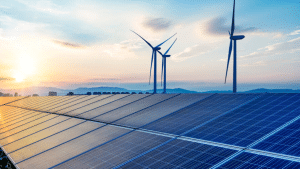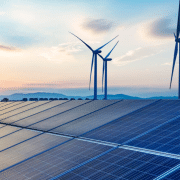The Time to Build a Foundation for Energy Transition Is Now

Written by Guilhermme Lisboa and Aman Sheth
As the world relies on fossil fuels for energy production and generation, the effects can be far-reaching—from potential property damage to an increase in greenhouse-gas emissions.
The concept of energy transition is changing how people obtain and use energy, moving them away from fossil fuels and toward sustainable energy options.
Countries and U.S. states are moving at their own pace toward energy transition—some faster than others. Within the United States, California, for instance, has an ambitious plan to achieve 100% clean energy by 2045. By 2030, the state plans to source 60% of energy from renewables. Washington State is calling for utilities to phase out coal-fired electricity from state portfolios by 2025 and achieve 100% clean energy by 2045.
While these targets are admirable (and many would argue necessary), they’re also going to be tough to meet in many cases due to the condition and age of power transmission and distribution infrastructure.
The current U.S. grid, for example, is several decades old. It’s also designed to be unidirectional (with power flowing in one direction from the grid to the consumer). But future power demands call for a bidirectional grid (power flowing to the consumer and also back to the grid) to support:
- Integration of renewable energy systems that allow consumers to infuse excess power generated by their solar and wind systems back into the grid
- Decentralization that enables energy to be generated closer to where it will be used
- Increased resilience by allowing stored energy to be tapped for backup power during outages
- Flexibility for energy flow that moves based on demand (consider electric vehicles, for example)
While target dates may seem far away—2030, 2045, etc.—they aren’t as far off as they seem. As power transmission and distribution companies work toward these goals, their efforts are further complicated by increasing energy loads due to factors like:
- New types of electricity users joining the grid, including electric vehicles and electric heat pumps
- Electricity consumption from data centers to train and run artificial intelligence
- Population and economic growth
This all means more transmission and distribution lines, more substations and more communications infrastructure amid this energy transition.
Digitalization: The Energy Transition Enabler
With clean-energy targets in place, power transmission and distribution companies must respond—and the only way they can do so is through digital transformation. According to the latest World Energy Investment report, grid-related investments in digital technologies was expected to reach 19% of total grid investment in 2023.
Energy transition requires more sophisticated grids—and refined management and control of these grids. It will also require power transmission and distribution companies to scale quickly.
Consider Brazil as an example of what can happen if your company isn’t prepared. Because of the country’s growth in clean energy and the creation of micro and mini power distributed generation, energy surpluses are being injected back into to Brazil’s grid—but its existing infrastructure isn’t equipped for it, which is causing reliability issues.
That’s where digitalization comes in. It can facilitate new capabilities to support energy transition, such as the three examples below.
1. Enabling Digital Substations
Digital substations replace analog components with digital components (think relays, meters, protection systems, etc.). Digital components are also connected through fiber optic cables.
These substations are almost like micro data centers, with infrastructure that provides power transmission and distribution companies with the capability to capture, utilize and transmit accurate, real-time data.
The digital operations, technologies, methods and processes enabled by digital substations support better visualization for system awareness and resilience. They also give utilities deeper access to their connected digital systems and the opportunity to standardize their data.
2. Supporting Operational Insights
Digital transformation enables power transmission and distribution companies to capture real-time data from their infrastructure (such as through the digital substations we mentioned above) so they can monitor and respond to:
- Energy demand
- The mix of energy sources being fed into the grid
- System uptime
- Performance issues
The ability to monitor not only operational technology (OT) data, but also data about network performance, will help utilities gain insight into network reliability to gauge problems like congestion or unauthorized access.
3. Enacting Predictive Maintenance
Through devices like sensors, smart meters and SCADA systems, utilities can monitor the condition of their systems and assets to detect operational anomalies, such as abnormal temperature readings or increased vibration.
These indicators may be early warning signs of failure. When deviations occur, alerts can automatically be sent to the correct teams so they can prioritize, respond to and address maintenance activities before they escalate to downtime.
Find the original article here






